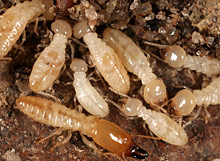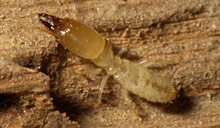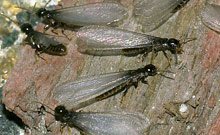Termites
How to deal with termites
 |
|
Termite colony. Photo by Gary Alpert, Env. Health & Safety, Harvard U. |
 |
|
Termite soldier. Photo by Gary Alpert, Env. Health & Safety, Harvard U. |
 |
|
Termite swarmers. Photo by Gary Alpert, Env. Health & Safety, Harvard U. |
Look around your home for termite-friendly areas and take steps to prevent: seal cracks in your foundation, replace water damaged wood, keep wood piles far away, direct downspouts away from the foundation, and fix leaks or moisture issues. Pressure treated wood deters them. Consider hiring a professional to inspect for termites.
Pest control companies with termite experience are key if termites are a threat in your area. Their treatments monitor for or stop termites before they get in. With lots of options out there, educate yourself and go for the least toxic and most effective choice.
What they look like
Their pale, plump bodies have no defined waist like an ant's would. Antennae look like a string of beads.
Unless you split open some infested wood, you're not likely to see termites crawling around. It's the winged ones—swarmers—that alert you to a nearby colony.
When colonies get crowded, some males and females, ready to reproduce, fly the coop. They look for a moist piece of wood that touches the ground, to start a new colony there. Swarms usually happen March through June on warm, humid days after a rainstorm. If you see them in your house, seek professional help asap. (Note: swarming ants have 4 wings of 2 different sizes and are narrow-waisted. Termite swarmers have 4 equal-sized wings and fat bodies with no waist.)
Where they live
Wooden studs, door or window frames, fences, floorboards, and wood near chimneys or hot water pipes (they like it warm and moist): all are attractive, so long as there's soil nearby. In fact, most termites live underground. Look for hollow mud tubes that cover their pathways. Colonies take 4 to 10 years to grow big enough to make swarmers. Throughout the summer, inspect around your house, especially ground-floor areas that could have a moisture problem.
What they do
A colony can contain hundreds of thousands of termites. They eat through wood, leaving hollow tunnels, lined with mud, in their wake.
Resources
University of Georgia Termite Guide
See results from the Northeastern IPM Center's resources database.
